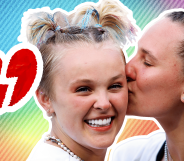Trans people are up to six times more likely to have autism and related conditions, landmark study confirms

Transgender and gender-diverse people have higher rates of autism than cisgender people, a landmark study has confirmed.
The research, published in the peer-reviewed scientific journal Nature Communications, also found that trans people are more likely to be diagnosed with schizophrenia, ADHD, bipolar disorder, depression, learning difficulties or OCD than cis people.
The authors, led by Varun Warrier from Cambridge University’s Autism Research Centre, used five large existing datasets to closely examine whether people who have autism are more likely to be trans, and vice versa — something that’s been posited by previous research, but only by studies using small sample sizes.
Their findings, the authors concluded, show that “transgender and gender-diverse individuals have elevated rates of autism diagnosis, related neurodevelopmental and psychiatric conditions, and autistic traits compared to cisgender individuals”.
“This study has clinical implications by highlighting that we need to improve access to care and tailored support for this under-served population,” they wrote.
Roughly one to two per cent of the population is estimated to be autistic while 0.4 to 1.3 per cent is estimated to be trans or gender-diverse.
Previous research into the links between autism and gender identity mostly used data from trans people who had been referred to a gender clinic, and had a typical sample size of “in [the] few hundreds”, the authors noted.
This created bias in terms of the type of trans person included — favouring those who have gender dysphoria, the resources to access a gender clinic and some support from family or friends in doing so — which would be exacerbated by the small sample size.
“It is important to understand what the odds are of being diagnosed as autistic in transgender and gender-diverse individuals at large, not solely in those recruited through GD [gender dysphoria] clinics,” the researchers said.
Trans people up to six times more likely to be autistic than cis people.
The scientist’s findings can be broken down into four key points.
First, across all five datasets used, trans and gender-diverse people are 3.03 to 6.36 times more likely to be autistic than cis people. This is after the researchers controlled for age and educational attainment.
Second, trans and gender-diverse people were significantly more likely to self-report autistics traits, systemising and sensory sensitivity, and scored lower on empathy traits than cis individuals.
Third, in two of the datasets, trans people were significantly more likely to have higher rates of other neurodevelopmental and psychiatric conditions, including OCD, schizophrenia, ADHD, learning difficulties, depression and bipolar disorder.
And finally, an “exploratory analysis” carried out by the researchers found that trans people were more likely to say that they suspected they had undiagnosed autism.
Explaining the overlap between an autism diagnosis and being transgender.
Making it clear that, for several reasons, their results are unlikely to be false positives, the researchers also stressed the importance of their finding that “this association with gender identity is not specific to autism”.
They also emphasised that more research into this area is needed — specifically, a more comprehensive investigation into the relative rates of each of the neurodevelopmental and psychiatric conditions in trans people compared to cis people.
In discussing why there might be this overlap between an autism diagnosis and being trans, the researchers considered that “autistic individuals may conform less to societal norms compared to non-autistic individuals, which may partly explain why a greater number of autistic individuals identify outside the stereotypical gender binary”.
Then, there is the role of “prenatal mechanisms” — like hormones that impact sex – which shape brain development and have been shown to contribute to both autism and gender role behaviour. But, the scientists said clearly, it is unclear if prenatal mechanisms also affect gender identity, and this needs further investigation.
“Finally, an alternative but not mutually exclusive explanation,” the researchers said, “is that transgender and gender-diverse individuals have elevated vulnerabilities for multiple psychiatric challenges related to stressful life experiences in the contexts of unfriendly environments, discrimination, abuse and victimisation, explaining the elevated rates of mental health diagnoses.”
Some caveats applied to their conclusions, the researchers said: in two of the datasets, intersex individuals were excluded, but this was not possible in the other three; in one dataset it was possible that non-binary people who don’t use the word “transgender” to describe themselves were excluded; and it is also possible that “gender-aware” individuals provided their sex, rather than gender.
“It is difficult to disentangle this,” the study concludes. “However, the magnitude of the sample size suggests that the effects of such misclassification will have a minimal effect on the analyses and findings.”

